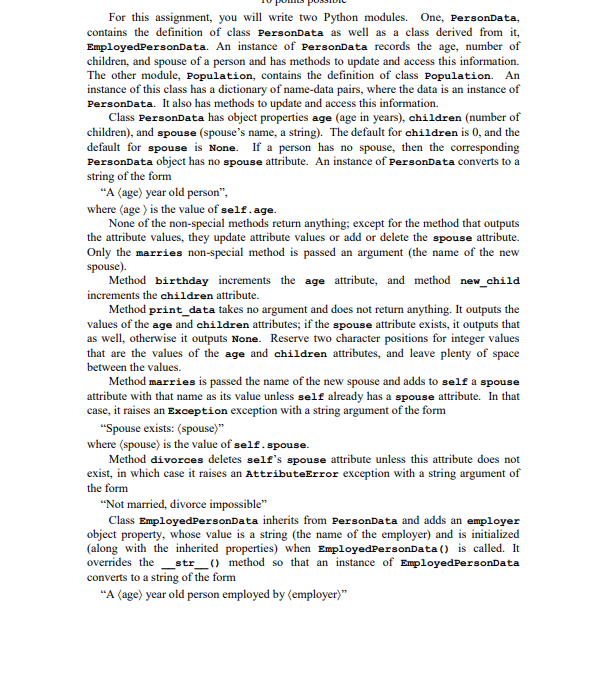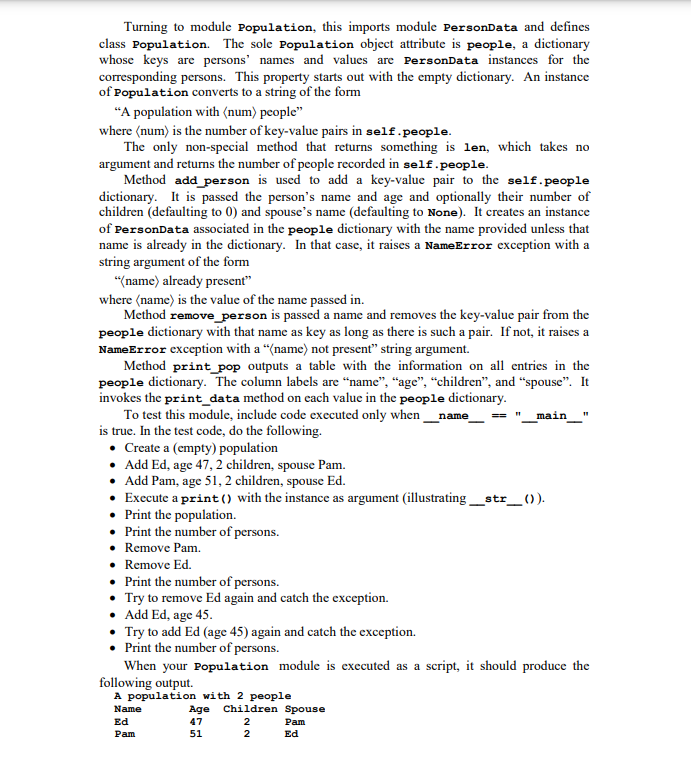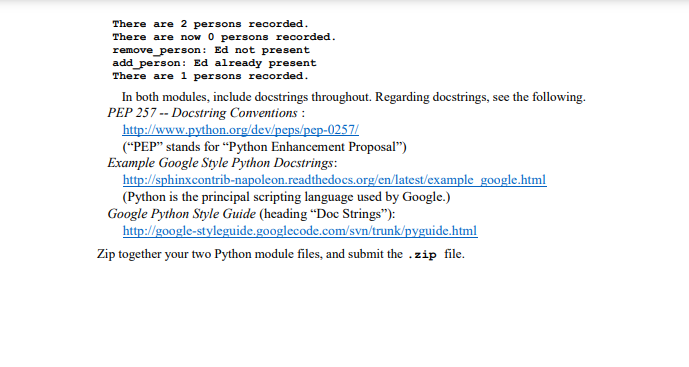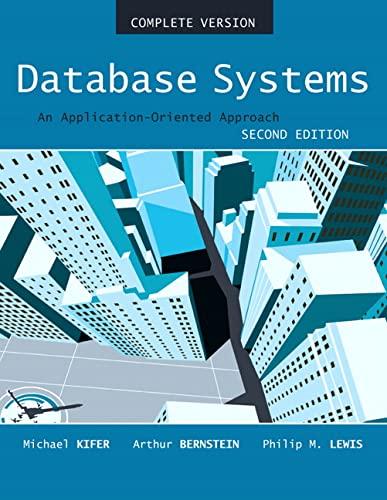



For this assignment, you will write two Python modules. One, PersonData, contains the definition of class Persondata as well as a class derived from it, EmployedpersonData. An instance of PersonData records the age, number of children, and spouse of a person and has methods to update and access this information. The other module, Population, contains the definition of class Population. An instance of this class has a dictionary of name-data pairs, where the data is an instance of PersonData. It also has methods to update and access this information. Class PersonData has object properties age (age in years), children (number of children), and spouse (spouse's name, a string). The default for children is 0 , and the default for spouse is None. If a person has no spouse, then the corresponding Persondata object has no spouse attribute. An instance of PersonData converts to a string of the form "A age> year old person", where (age ) is the value of self. age. None of the non-special methods return anything; except for the method that outputs the attribute values, they update attribute values or add or delete the spouse attribute. Only the marries non-special method is passed an argument (the name of the new spouse). Method birthday increments the age attribute, and method new_child increments the children attribute. Method print_data takes no argument and does not return anything. It outputs the values of the age and children attributes; if the spouse attribute exists, it outputs that as well, otherwise it outputs None. Reserve two character positions for integer values that are the values of the age and children attributes, and leave plenty of space between the values. Method marries is passed the name of the new spouse and adds to self a spouse attribute with that name as its value unless self already has a spouse attribute. In that case, it raises an Exception exception with a string argument of the form "Spouse exists: (spouse)" where (spouse) is the value of self. spouse. Method divorces deletes self's spouse attribute unless this attribute does not exist, in which case it raises an AttributeError exception with a string argument of the form "Not married, divorce impossible" Class EmployedpersonData inherits from PersonData and adds an employer object property, whose value is a string (the name of the employer) and is initialized (along with the inherited properties) when EmployedpersonData() is called. It overrides the str_() method so that an instance of EmployedPersonData converts to a string of the form "A age year old person employed by (employer)" where (age ) is the value of self. age and (employer) is the value of self. employer. It also overrides the print_data () method so that (besides all the values printed with an instance of Persondata) it also prints the value of self. employer. Include in your Persondata module the following code (available as test_code1.py on the assignment page) to be executed when the module is executed as a script. When your persondata module is executed as a script, it should produce the following output. A 31 year old person 312 Sue 323 None Spouse exists: Pam Not married, divorce impossible 390 None A 31 year old person employed by Google 31 Google Tom Hints Where o is an object and a is an attribute, del o.a removes attribute a from 0 , and hasattr (o, "a") returns True if o has attribute a (and False otherwise). 2 Turning to module Population, this imports module PersonData and defines class Population. The sole Population object attribute is people, a dictionary whose keys are persons' names and values are PersonData instances for the corresponding persons. This property starts out with the empty dictionary. An instance of Population converts to a string of the form "A population with num people" where num is the number of key-value pairs in self. people. The only non-special method that returns something is len, which takes no argument and returns the number of people recorded in self.people. Method add_person is used to add a key-value pair to the self.people dictionary. It is passed the person's name and age and optionally their number of children (defaulting to 0 ) and spouse's name (defaulting to None). It creates an instance of PersonData associated in the people dictionary with the name provided unless that name is already in the dictionary. In that case, it raises a NameError exception with a string argument of the form Method remove_person is passed a name and removes the key-value pair from the people dictionary with that name as key as long as there is such a pair. If not, it raises a NameError exception with a "'name not present" string argument. Method print_pop outputs a table with the information on all entries in the people dictionary. The column labels are "name", "age", "children", and "spouse". It invokes the print_data method on each value in the people dictionary. To test this module, include code executed only when __ name _ == " main __" is true. In the test code, do the following. - Create a (empty) population - Add Ed, age 47, 2 children, spouse Pam. - Add Pam, age 51, 2 children, spouse Ed. - Execute a print() with the instance as argument (illustrating str ()). - Print the population. - Print the number of persons. - Remove Pam. - Remove Ed. - Print the number of persons. - Try to remove Ed again and catch the exception. - Add Ed, age 45. - Try to add Ed (age 45) again and catch the exception. - Print the number of persons. When your Population module is executed as a script, it should produce the following output. A population with 2 people There are 2 persons recorded. There are now 0 persons recorded. remove_person: Ed not present add_person: Ed already present There are 1 persons recorded. In both modules, include docstrings throughout. Regarding docstrings, see the following. PEP 257 -- Docstring Conventions : http://www.python.org/dev/peps/pep-0257/ ("PEP" stands for "Python Enhancement Proposal") Example Google Style Python Docstrings: http://sphinxcontrib-napoleon.readthedocs.org/en/latest/example google.html (Python is the principal scripting language used by Google.) Google Python Style Guide (heading "Doc Strings"): http://google-styleguide.googlecode.com/svn/trunk/pyguide.html Zip together your two Python module files, and submit the . zip file










